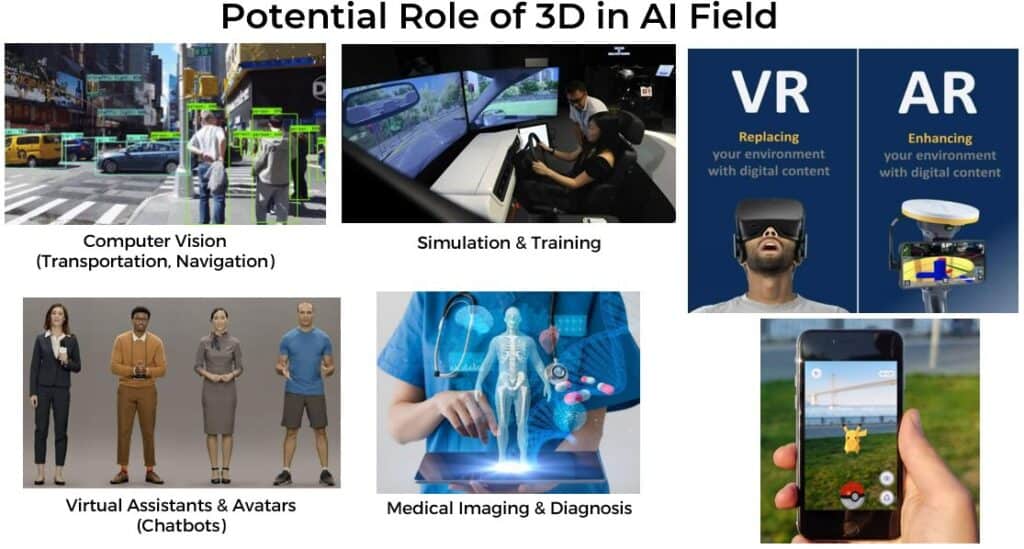In recent years, the world of technology has witnessed a remarkable advancement in 3D development. This cutting-edge technology has transcended the boundaries of traditional two-dimensional representations and has found widespread application in diverse industries.
From gaming and entertainment to education and architecture, 3D development technology and software have become the driving force behind the creation of immersive and visually stunning experiences.
Can the revolutionary realm of 3D technologies also leave a lasting imprint on the field of AI?
In this article, we will delve into the fundamentals of 3D development technology, explore its current applications, and ponder upon its boundless future potential.
Additionally, we have also investigated the possibilities of investing in 3D software development companies. To find out more, click the link below or watch on our YouTube Channel!
WHAT IS 3D DEVELOPMENT TECHNOLOGY & SOFTWARE?
At its core, 3D development technology is a process that enables the creation, manipulation, and rendering of three-dimensional objects in a virtual environment. By using specialized software, developers can model objects with height, width, and depth. This offers a lifelike representation of real-world items.

Some of the widely used 3D development software includes industry favorites like Blender, Autodesk Maya, Unity, and Unreal Engine. These tools provide designers and developers with the necessary resources to bring their creative visions to life through intricate and realistic 3D models.
WHERE IS THIS TECHNOLOGY BEING USED?
The versatility of 3D development technology has paved the way for its extensive use across various sectors.
- In the gaming industry, 3D graphics have elevated gaming experiences to unprecedented heights, immersing players in incredibly detailed virtual worlds.
- Similarly, the film and entertainment industry have embraced 3D technology to create breathtaking visual effects and lifelike animated characters.
- In architecture and engineering, 3D modeling has become an indispensable tool, enabling professionals to design and visualize complex structures before they are constructed.
- Additionally, the educational sector has adopted 3D technology to facilitate interactive learning experiences. This allows students to explore subjects in a more engaging and immersive manner.
WHAT IS THE FUTURE POTENTIAL OF THIS TECHNOLOGY?
The future potential of 3D development technology is nothing short of awe-inspiring. As this technology continues to evolve, we can expect even more lifelike and hyper-realistic visual experiences across various media platforms.
Virtual Reality (VR) and Augmented Reality (AR) will further integrate with 3D development, transcending the boundaries between the digital and physical worlds. This integration will not only revolutionize entertainment and gaming, but also create innovative solutions for training, simulations, and remote collaboration in fields like healthcare and industrial sectors.
Moreover, with the advent of 3D printing technology, 3D models can be transformed into tangible objects, revolutionizing manufacturing and prototyping processes.
3D TECHNOLOGIES & AI
3D development technologies are set to play a crucial role in the AI field, unlocking new frontiers for artificial intelligence applications.

By integrating 3D modeling and rendering capabilities with AI algorithms, developers can create sophisticated AI-driven simulations that interact with lifelike 3D environments. These simulations offer valuable training opportunities for AI systems, allowing them to learn and adapt in realistic scenarios.
In fields like robotics and autonomous vehicles, 3D environments enable AI algorithms to better understand the complexities of the real world with computer vision to identify objects. This will help to enhance their decision-making capabilities and safety measures.
Moreover, the utilization of 3D data visualization and representation enhances AI-powered data analysis and pattern recognition capabilities. By harnessing these functionalities, businesses and researchers can delve into intricate datasets, extract profound insights, and base their decisions on well-analyzed data.
The seamless integration of 3D development technologies and AI is poised to revolutionize various industries and drive the next wave of innovation in artificial intelligence.
CONCLUSION
In conclusion, 3D development technology and software have emerged as a game-changer across numerous industries. Its ability to create immersive experiences, enhance safety, and improve accessibility has left an indelible mark on modern-day technology.
Moving forward, the potential of 3D development technology looks incredibly promising, especially with lifelike visual experiences such as Virtual Reality (VR) and Augmented Reality (AR). Companies involved in this technology may have the opportunity to capitalize on this trend and potentially become major players in the industry.
Moreover, the significance of 3D technology in the AI field cannot be overstated. It enables advanced AI simulations and data analysis in realistic 3D environments, leading to revolutionary changes in various industries and driving innovation for a technologically advanced and immersive future.
If you’ve ever had the desire to actively engage in your investment journey, acquire skills in analyzing and investing in companies that may benefit in these innovative technologies, join us in our masterclass by clicking on the banner below to learn more how to:
- Generate 3 Sources of Passive Income even if you know Nothing about investing.
- Invest with minimal capital.
- Create a Cash Dispensing Machine to replace your existing salary.
DISCLOSURE
The above article is for educational purposes only. Under no circumstances does any information provided in the article represent a recommendation to buy, sell or hold any stocks/asset. In no event shall ViA or any Author be liable to any viewers, guests or third party for any damages of any kind arising out of the use of any content shared here including, without limitation, use of such content outside of its intended purpose of investor education, and any investment losses, lost profits, lost opportunity, special, incidental, indirect, consequential or punitive damages resulting from such unintended use.














